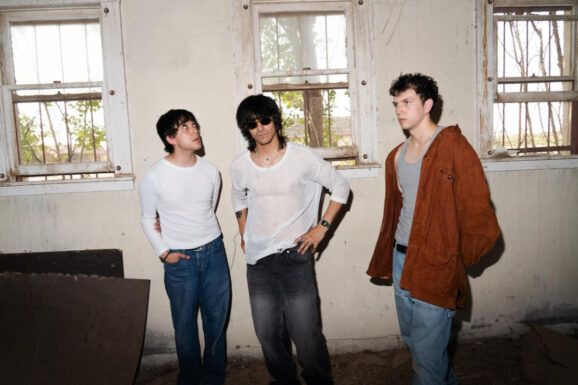In lieu of a new archive release for early 2019, the Experience Hendrix team hearkens to a previous exhumation from the vault for selected nationwide theatrical showings of Electric Church, a film documenting the late guitar icon’s performance at the 1970 Atlanta Pop Festival. Somewhat admirable these limited movie house runs do not constitute any heavy-handed marketing, it is nevertheless something of an oversight not to reference previously-issued video configurations. But doing so might call undue attention to the fact the content supplied to cinemas, contrary to some on-line synopses, has been edited down from those aforementioned releases, most dramatically through the deletion of two performances that put Hendrix’ appearance in a wholly different light.
As seen on April 15, the first of two showings in Vermont,the Jimi Hendrix Experience offers a selection of material, including “Fire” and “Foxy Lady” that may hold great appeal for a mainstream audience, but nevertheless belies the man’s artistic evolution in the three years since his debut Are You Experienced?. Omitting “Red House” is significant enough since that blues, like the two aforementioned numbers, also appeared on the 1967 album. But without the liberated introspection represented by “Roomful of Mirrors” early in the hour-plus set, a tune of similar vintage, “Straight Ahead” (appearing posthumously on The Cry of Love) seems almost a non-sequitur positioned as the show closer of the encore. Like the show as a whole, that number and “Freedom” barely hint at Hendrix’ ambitious pursuits during the period, including the construction of the Electric Lady recording studio complex in New York.
Notwithstanding all that, the concert still becomes a mesmerizing experience to watch as projected on the giant screen. Heightening the impact of the musicianship are repeated extreme close-ups, particularly of Hendrix’ hands spanning the fretboard of his Fender, often extending off the whammy bar to pick the strings. With drummer Mitch Mitchell and bassist Billy Cox following along, almost straining to keep up at times, Jimi avoids his latent boredom with the songs through a borderline free-form exploration of his instrument. Thankfully, the audio quality on the Palace 9 digital sound system was well-balanced, especially in terms of volume.
Tellingly, apart from his personal reading of “All Along The Watchtower,” Hendrix’ vocals are also almost afterthoughts, marginally superfluous interludes in a blues-drenched flow of notes, as often as not erupting with blistering, distorted intensity. Like the Bob Dylan tune a cull from Electric Ladyland, “Voodoo Child (Slight Return)” is one of only a few passages eliciting an audible response from an audience whose real-time acknowledgments of the setlist remains relegated to a minimum on the soundtrack. Of course, many of the five-hundred thousand or so may well have paid more attention to the man in the free-flowing kaleidoscopic colored satin than to the fireworks launched, predictably, during “Star Spangled Banner.” (which Hendrix had laughingly teased on his intro of “Purple Haze” by asking the crowd to stand).
Apart from eye-catching shots of Mitchell’s silhouette cast in shadows on the wall of amplifiers, arms akimbo in perpetual motion, there’s little creativity to the multi-camera shoots of the truncated performance. With the hindsight of nearly a half century, the documentary footage is also extremely dated on some fronts: positioning this second Atlanta Pop as ‘the last great festival’ is surely an obsolete premise by now. But it was an enlightened decision on the part of the original filmmakers, including the director, author/biographer/archivist John McDermott, to place the festival in the context of civil rights unrest (uncomfortably relevant here in 2019), the relenting toll of the Vietnam War and a burgeoning alternative culture of the time.
Those varying and often (unintentionally) laughable perspectives become even more illuminating in retrospect, including most especially the significance of Hendrix as the headliner. Interviews with festival principals including Dixie promoter Alex Cooley and a few genuinely bemused Georgia locals add some color to the narrative. But, apart from the pertinent insight of Rich Robinson (Black Crowes, The Magpie Salute), snippets of conversation with otherwise inarticulate musicians barely scratch the surface of how profoundly influential a position the late guitarist had assumed at this point in his career: in the absence of the Beatles and Bob Dylan from live performance (the Rolling Stones had only returned to the road the year prior), Jimi had fully and completely filled that void, an elevated stature that accounted for his status at the top of this Atlanta Pop Festival bill.
Nearly-five decades on, even in its abbreviated form, Electric Church makes that point worth pondering. And while the movie’s limited release suggests the archives of the late rock icon may be grievously depleted, it also hints at the possibility of more (and regular?) such showings, a la the Grateful Dead’s annual Meet Up at the Movies (which garnered similarly paltry attendance at the outset of the series). Screenings of the complete Woodstock and/or Monterey Pop performances hold the same potential for rediscovery, even if, as in this case, the presentation is not truly exhaustive. After all, if any contemporary musician deserves a larger-than-life depiction, it is Jimi Hendrix.









